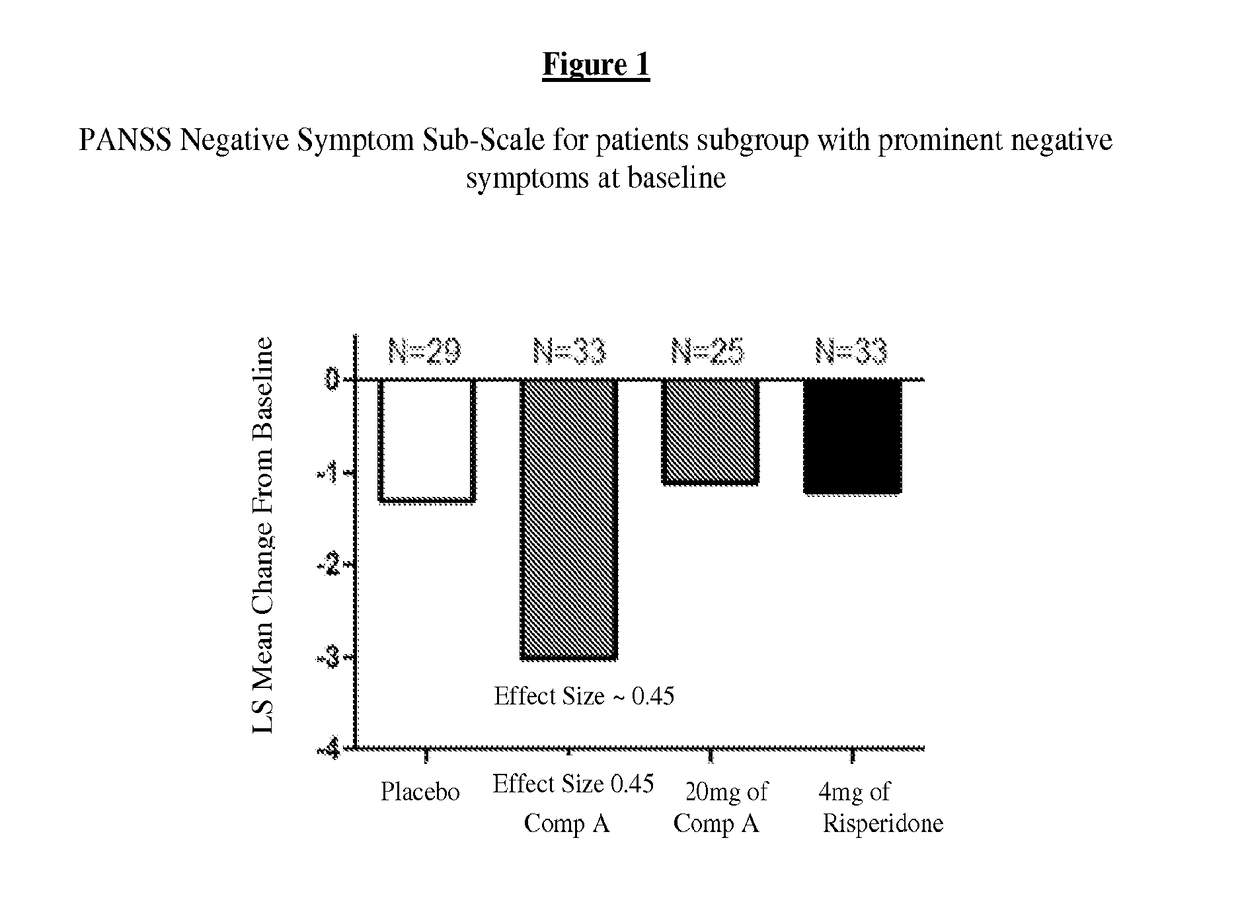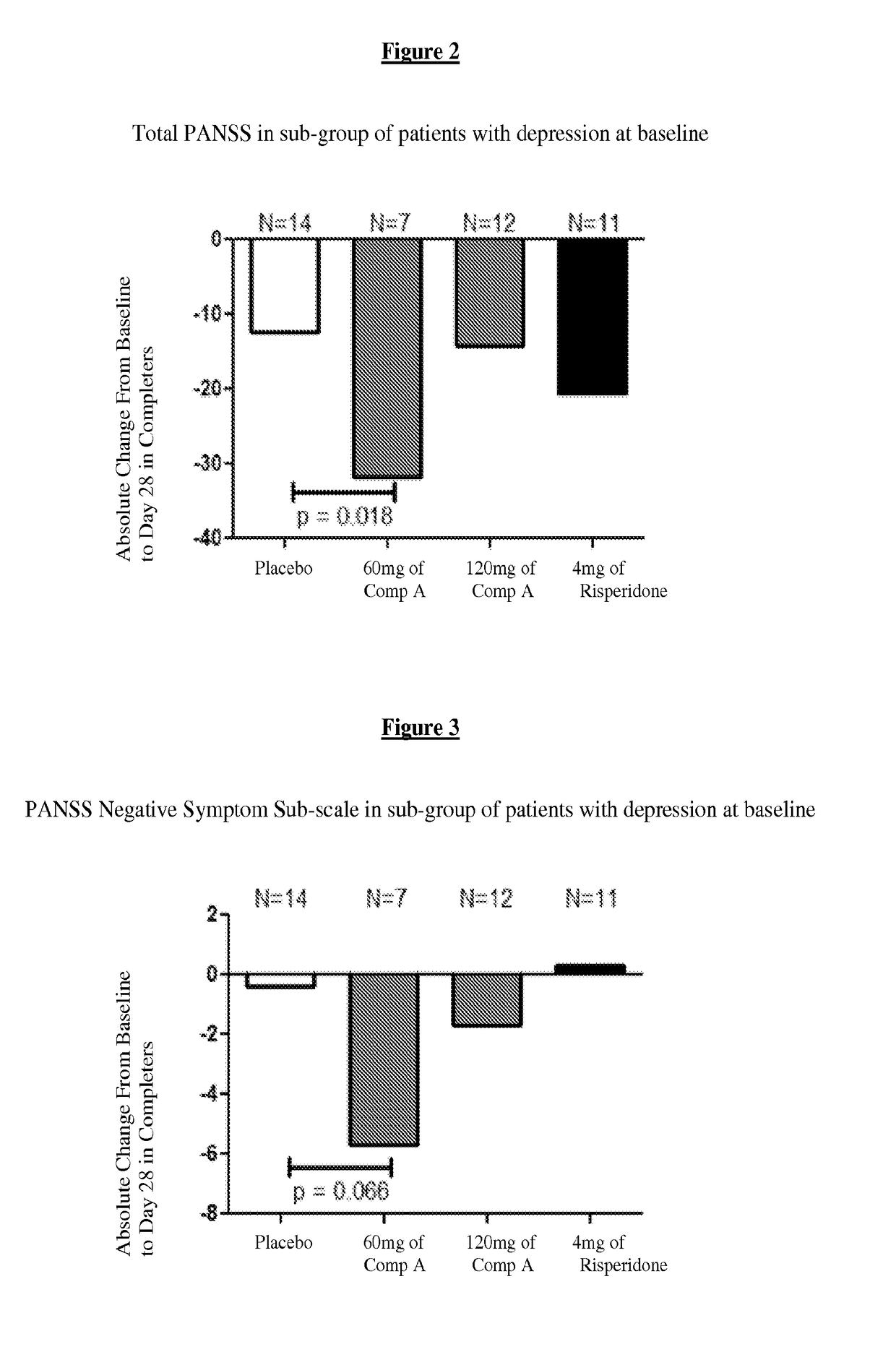Method for the treatment of residual symptoms of schizophrenia
a residual symptoms and treatment method technology, applied in the direction of capsule delivery, drug composition, microcapsules, etc., can solve the problems of loss of interest in usual pursuits, withdrawal from friends and family members, trouble with concentration, etc., to stimulate the phosphorylation of glutamatergic, enhance social function, and improve the quality of life of patients
- Summary
- Abstract
- Description
- Claims
- Application Information
AI Technical Summary
Benefits of technology
Problems solved by technology
Method used
Image
Examples
example 1
Treatment of Acute as Well as Residual Symptoms of Schizophrenia
[0233]For purposes of this example, Compound A refers to the compound of Formula I wherein X is —N(CH3)— and Y is —C(O)—; tosylate salt unless otherwise indicated. A randomized, double-blind, placebo-controlled, in-patient trial is performed. Four treatment arms, 4-week treatment duration, QAM dosing are performed as follows: 60 mg of Compound A; 120 mg of Compound A; positive control (4 mg Risperidone); and placebo. The primary outcome is measured by the change from baseline on Positive and Negative Syndrome Scale (PANSS) Total Score at Day 28. Secondary measures explore key differentiating features.
[0234]60 mg Compound A Treatment Arm receives 60 mg of Compound A once daily for 28 days. 120 mg Compound A Treatment Arm receives 60 mg Compound A on Study Day 1 followed by 120 mg Compound A once daily for 27 days. Risperidone Treatment Arm receives 2 mg risperidone on Study Day 1 followed by 4 mg risperidone once daily f...
examples 2-10
Preparation of Long-Acting Injectable Microsphere Formulations
example 2
Preparation of the PLGA (PLA / PLG=75 / 25, 0.32-0.44 dl / g) Microspheres of Compound a Free Base (Lot A)
[0242]For purposes of Examples 2-10, Compound A refers to the compound of Formula I wherein X is —N(CH3)— and Y is —C(O)— in free base form.
[0243]2 g of Poly(vinyl alcohol) (PVA, 87-89% hydrolyzed, typical molecular weight 13,000-23,000) in 400 mL of deionized water is sonicated in a bath sonicator for 5-10 min and then filtered to give 0.5% PVA aqueous solution. The filtrate is transferred to a 500 mL flat bottom flask. 0.80 g of Compound A and 1.2 g of PLGA polymer (PLA / PLG=75 / 25, 0.32-0.44 dl / g, acid end groups) are dissolved in 15 mL of dichloromethane. This solution is added into the 0.5% PVA aqueous solution dropwise with vigorous stirring. A mechanical overhead stirrer is used and the stirring speed is around 700 ppm during the addition. After the completion of the addition, the mixture is stirred at this speed for an hour and then stirred at approximately 550 ppm for 4 hours. ...
PUM
| Property | Measurement | Unit |
|---|---|---|
| weight-average molecular weight | aaaaa | aaaaa |
| weight-average molecular weight | aaaaa | aaaaa |
| weight-average molecular weight | aaaaa | aaaaa |
Abstract
Description
Claims
Application Information
 Login to View More
Login to View More - R&D
- Intellectual Property
- Life Sciences
- Materials
- Tech Scout
- Unparalleled Data Quality
- Higher Quality Content
- 60% Fewer Hallucinations
Browse by: Latest US Patents, China's latest patents, Technical Efficacy Thesaurus, Application Domain, Technology Topic, Popular Technical Reports.
© 2025 PatSnap. All rights reserved.Legal|Privacy policy|Modern Slavery Act Transparency Statement|Sitemap|About US| Contact US: help@patsnap.com



